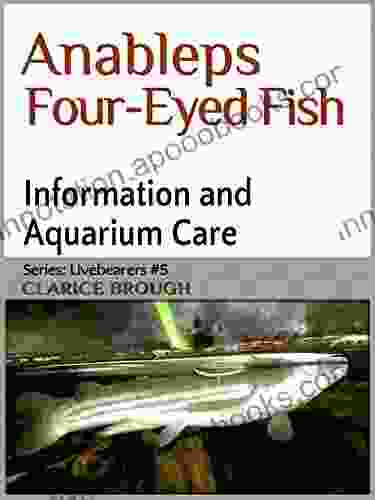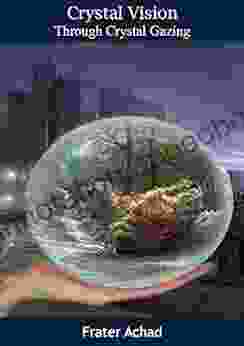Unveiling the Wonders of Four-Eyed Fish Livebearing Fish: A Comprehensive Guide

: Delving into the Aquatic Realm
The underwater world is home to a mesmerizing array of creatures, each with its own unique adaptations and captivating characteristics. Among these aquatic wonders are four-eyed fish and livebearing fish, both captivating groups that have captivated the interest of aquarists and fish enthusiasts alike.
Chapter 1: Four-Eyed Fish: Exploring Their Unique Anatomy and Adaptations
Four-eyed fish, scientifically classified as Anablepidae, are a family of fish that possess a distinct and intriguing physical feature: they have two pairs of eyes. The upper pair of eyes is located above the water's surface, providing them with a panoramic view of their surroundings. Meanwhile, the lower pair of eyes is situated below the waterline, allowing them to observe the underwater environment.
4.6 out of 5
| Language | : | English |
| File size | : | 681 KB |
| Text-to-Speech | : | Enabled |
| Enhanced typesetting | : | Enabled |
| Print length | : | 16 pages |
| Screen Reader | : | Supported |
This remarkable adaptation grants four-eyed fish an exceptional field of vision, enabling them to spot predators, potential mates, and food sources with remarkable efficiency. Their eyes are also highly sensitive to light, allowing them to thrive in both bright and low-light conditions.
Four-eyed fish exhibit a wide range of physical characteristics, with different species displaying varying body shapes, sizes, and coloration. Some species, such as the four-eyed fish (Anableps anableps),are relatively small, reaching only around 6 inches in length. Others, like the giant four-eyed fish (Anableps microlepis),can grow up to an impressive 12 inches in size.
Chapter 2: Livebearing Fish: Understanding Their Reproductive Strategy
Livebearing fish, belonging to the superFree Download Acanthopterygii, are a diverse group of fish characterized by their unique reproductive strategy. Unlike egg-laying fish, livebearing fish give birth to live offspring. This adaptation allows them to protect their young from predators and ensure their survival in various aquatic environments.
The process of livebearing varies slightly among different species. In general, female livebearing fish develop specialized reproductive organs, known as ovaries, where eggs are fertilized internally. Once the eggs are fertilized, they remain within the female's body, receiving nourishment and protection until they are ready to be born.
When the time comes, the female livebearing fish gives birth to fully developed, free-swimming fry. These tiny fish are equipped with the necessary instincts and physical adaptations to survive independently. The number of fry produced in each litter varies depending on the species, with some species producing only a handful of young while others may give birth to hundreds at a time.
Examples of popular livebearing fish include guppies, mollies, platys, and swordtails. These fish are renowned for their vibrant colors, distinctive patterns, and ease of care, making them popular choices among aquarium enthusiasts.
Chapter 3: Four-Eyed Fish and Livebearing Fish: A harmonious Coexistence
Four-eyed fish and livebearing fish often coexist harmoniously in their natural habitats. Four-eyed fish typically inhabit the surface waters, using their binocular vision to scan for predators and prey. Livebearing fish, on the other hand, tend to occupy the lower water levels, where they feed on algae, small invertebrates, and plant matter.
This complementary distribution of habitat minimizes competition between the two groups of fish, allowing them to thrive in the same aquatic ecosystem. In some cases, four-eyed fish may even act as a protective barrier for livebearing fish, using their unique eyesight to warn of approaching danger.
Aquarium enthusiasts can successfully replicate this harmonious coexistence by providing a tank with a variety of depths and hiding places to cater to the different preferences of four-eyed fish and livebearing fish. By mimicking their natural habitat, aquarists can create a thriving underwater environment where both groups of fish can flourish.
Chapter 4: Establishing and Maintaining a Four-Eyed Fish and Livebearing Fish Aquarium
Creating a thriving aquarium for four-eyed fish and livebearing fish requires careful planning and proper care. Here are some essential considerations:
Tank Size and Dimensions:
The size of the tank will depend on the number and size of fish you intend to keep. As a general rule, provide at least 1 gallon of water for every inch of fish. For example, a 20-gallon tank is suitable for a small group of four-eyed fish and livebearing fish.
Water Quality:
Four-eyed fish and livebearing fish prefer slightly alkaline water with a pH of around 7.0-8.0. The water should also be free of ammonia and nitrites, which can be harmful to fish. Regular water changes and a reliable filtration system are essential for maintaining water quality.
Temperature:
Four-eyed fish and livebearing fish prefer warm water temperatures, typically between 75-82°F (24-28°C). Use a reliable aquarium heater to maintain a stable temperature within this range.
Planting and Decoration:
Provide a variety of plants and hiding places in the tank to cater to the different needs of four-eyed fish and livebearing fish. Live plants not only provide shelter but also improve water quality. Artificial plants can also be used to supplement live plants.
Feeding:
Four-eyed fish are primarily carnivorous, feeding on small insects, fry, and other live prey. Livebearing fish are omnivorous, eating a variety of
4.6 out of 5
| Language | : | English |
| File size | : | 681 KB |
| Text-to-Speech | : | Enabled |
| Enhanced typesetting | : | Enabled |
| Print length | : | 16 pages |
| Screen Reader | : | Supported |
Do you want to contribute by writing guest posts on this blog?
Please contact us and send us a resume of previous articles that you have written.
 Book
Book Novel
Novel Page
Page Chapter
Chapter Text
Text Story
Story Genre
Genre Reader
Reader Library
Library Paperback
Paperback E-book
E-book Magazine
Magazine Newspaper
Newspaper Paragraph
Paragraph Sentence
Sentence Bookmark
Bookmark Shelf
Shelf Glossary
Glossary Bibliography
Bibliography Foreword
Foreword Preface
Preface Synopsis
Synopsis Annotation
Annotation Footnote
Footnote Manuscript
Manuscript Scroll
Scroll Codex
Codex Tome
Tome Bestseller
Bestseller Classics
Classics Library card
Library card Narrative
Narrative Biography
Biography Autobiography
Autobiography Memoir
Memoir Reference
Reference Encyclopedia
Encyclopedia Mick Herron
Mick Herron Christi Phillips
Christi Phillips Ola Rotimi
Ola Rotimi Chyana Marie Sage
Chyana Marie Sage Chitra Sankaran
Chitra Sankaran Chris Vines
Chris Vines Clare Lindeque
Clare Lindeque David Limbaugh
David Limbaugh Margaret Meloni
Margaret Meloni Elizabeth Mckenna
Elizabeth Mckenna Chris Walter
Chris Walter Chelsea Luna
Chelsea Luna Chelle Bliss
Chelle Bliss Chris Ogden
Chris Ogden Cheng Li
Cheng Li Chris Eyles
Chris Eyles Martin Loughlin
Martin Loughlin Randy Aldcroft
Randy Aldcroft Graham Whittaker
Graham Whittaker Wilkie Collins
Wilkie Collins
Light bulbAdvertise smarter! Our strategic ad space ensures maximum exposure. Reserve your spot today!

 Osamu DazaiDog Food Recipes For Kidney And Heart Health: Nurture Your Pet's Well-being...
Osamu DazaiDog Food Recipes For Kidney And Heart Health: Nurture Your Pet's Well-being...
 Simon MitchellWhy You Have Been Attracting The Wrong Guys And How To Attract The Ones Who...
Simon MitchellWhy You Have Been Attracting The Wrong Guys And How To Attract The Ones Who... Jamison CoxFollow ·12.1k
Jamison CoxFollow ·12.1k Douglas FosterFollow ·18.6k
Douglas FosterFollow ·18.6k Nikolai GogolFollow ·15.2k
Nikolai GogolFollow ·15.2k Benjamin StoneFollow ·5.2k
Benjamin StoneFollow ·5.2k Andres CarterFollow ·4.6k
Andres CarterFollow ·4.6k Ervin BellFollow ·10.9k
Ervin BellFollow ·10.9k Dalton FosterFollow ·2.2k
Dalton FosterFollow ·2.2k Ian McEwanFollow ·4.3k
Ian McEwanFollow ·4.3k

 Kevin Turner
Kevin TurnerDive into the Enchanting World of "Crazy Like Fox": A...
Prepare yourself for a literary adventure...

 Ralph Waldo Emerson
Ralph Waldo EmersonUnlock the Elegance of Daffodil Lace: An Immersive Guide...
: A Tapestry of Delicate...

 Gerald Parker
Gerald ParkerNever Lose An Argument Again: 20 Powerful Techniques From...
Are you tired of losing...

 Xavier Bell
Xavier BellSeven Animal Insertions Filet Crochet Pattern: Embark on...
Welcome to the captivating...

 Eugene Powell
Eugene PowellMagomago in TDS Magomago 12: An Unforgettable Adventure...
Step into the Enchanting World of...

 Marvin Hayes
Marvin HayesSoft Felting Needle Holder Excellence In Reborn Artistry
Unveiling the Secrets of the...
4.6 out of 5
| Language | : | English |
| File size | : | 681 KB |
| Text-to-Speech | : | Enabled |
| Enhanced typesetting | : | Enabled |
| Print length | : | 16 pages |
| Screen Reader | : | Supported |








